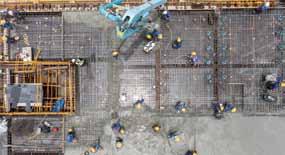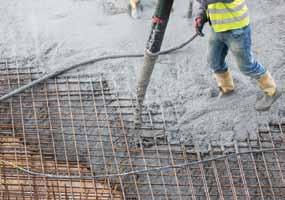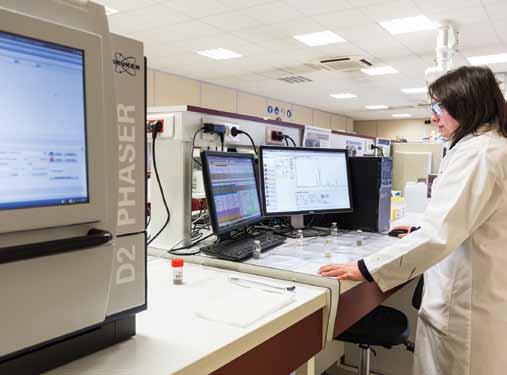
5 minute read
Akane
“Dependent on the material to be used, mix designers try avoid natural sands such as river sands and filler sands – in order to reduce their carbon footprint, and Co2 emissions – which would normally be used in a mix and which gives the pastiness to the concrete.
“Where concrete lacks that pastiness, contractors use pumping aids, whether it be a viscosity modifier or something similar to help keep the concrete together so it can pump without segregating. The mix for pump concrete contains less stone than conventional concrete, due to the need for lubrication. Pumping-aids lubricate the pipes and ensure the concrete pumps smoothly while ensuring the concrete in the pump doesn’t segregate,” explains Flannigan.
Advertisement
OPERATOR ExPERiENCE COuNTS
“Experienced pump operators know the ideal pump pressure for their equipment rather than just using a visual assessment of the slump. It’s not necessarily a wetter mix that’s going to pump easily. Therefore it’s better to select someone as a pump operator who is either a technical person or a technical supervisor, as that knowledge enables them to determine the pumpability of the mix. otherwise, if it’s wet it might look like its segregating – it looks stony – even though there
might be enough paste in it. one can immediately see what the mix is like from the pump pressure if it’s too wet to pump. Even if an experienced pump operator can visually see the slump of the concrete, I don’t think they should make a call on it,” says Flannigan. Patrick Flannigan, In the event of the slump being technical manager inadequate, he says rather than simply at CHRYSO Southern Africa. adding water there can be added to the concrete a ‘slump-rescue pack’ which contains one of the long chain polymer derivatives to increase the slump, without changing the water cement ratio. “Consequently, it won’t have any negative effect when it comes to early or late strengths. Why contractors tend to steer away from this quick-fix is that once their operators see the ease of pumping they will want to use it continuously – and it does add to the cost of the concrete. one can see its advantage immediately in the pump pressure as soon as the pack is put in – it gives a soft icing-like consistency to the concrete. For pump concrete one needs filler sand and an admixture can compensate for the lack of sand to give it flow. The main purpose of using superplasticisers is to produce flowing concrete with a high slump.
“A superplasticiser gives a nice pump pressure and depending on the distance to be pumped the admixture maintains slump retention for quite some time with no build-up in the pipeline,” he adds.
Although the slump-rescue pack comes at a cost and could not be used for every load unless budgeted for, Flannigan says there are certain situations where it is a cost benefit: “For


Admixtures improve concrete quality, manageability and acceleration or retardation of setting time. instance when a team is on site, and there may be labour issues whereby they cannot change shutters, or a pump breaks down or there’s a row of trucks backed up, then the product will be well worthwhile as it can save the concrete and still enable it to be used without sending back or dumping a six-cube truck.”

wHAT ADMixTuRE TO uSE AND wHAT TO AVOiD
He cautions that some admixtures should be avoided in pumping concrete. one is an air entrainer in which entrained air bubbles act as a physical buffer against the cracking caused by the stresses due to water volume augmentation. “one should not permit that compression effect in the pump. They call it the ‘concertina effect’ as it pushes the air out but doesn’t move the concrete, thereby blocking the pump.
“Accelerators too tend to be avoided over long-distance pours. In that case, and in high rises, an open time retarder can be used in conjunction with normal plasticisers and superplasticisers – but it is not recommended to be used on its own. What admixture is used will be determined in the lab that develops the mix design.
“A mix design typically aims to lower the volume of cementitious material and coarse aggregate, reducing the stone size with more water for a more flowable mix. However, by reducing the stone content to create space, one actually increases the likelihood of shrinkage and cracks. The only way to overcome that risk is by using a superplasticiser. you can get away with a plasticiser but most contractors prefer a superplasticiser for its water reduction ability and which in turn provides extra flow without using too much water or too much cementitious materials like fly ash, slagment or something similar.
“If anybody is not using admixture they are throwing away money because it’s biggest benefit lies in lowering cost. There is the added benefit of reducing one’s carbon footprint, as

Research and development in admixtures is heavily focused on greener cement and concrete products.
well as producing a more durable concrete. The only way you can reduce that is by using an admixture,” he explains.
R&D iN ADMixTuRES
“research and development (r&D) in admixtures is heavily focused on ‘greener’ cement and concrete products. This trend is accentuated by a global shortage of decent natural sands – though this is not yet prevalent in Africa. For pump concrete one needs filler sand and an admixture can compensate for the lack of sand to give it flow. All the r&D under way at the moment is to do with sustainability: clinker reduction, less Co2 emissions by using more extenders, fly-ash, slagment, limestone and the like. These all reduce costs by reducing cement content by up to 50% in the case of slagment and 30% in the case of fly-ash. This is particularly important for developers wanting their buildings to gain green accreditation.”
Flannigan notes that historically, when it comes to long chain polymers the older generation superplasticisers were made from by-products from the paper industry and elsewhere. “The newer generation polymers are bespoke products for a specific purpose or a specific aggregate so that it all works together seamlessly.
“This means when contractors come on site for a certain project they will be able to do that project using locally sourced material. They will not have to transport or truck materials in from far away to meet their demands. The admixtures can help control issues like clay content and bad gradings whether from lack of fines or excess of fines. r&D developments in admixtures are making their job a lot easier,” suggests Flannigan. n










